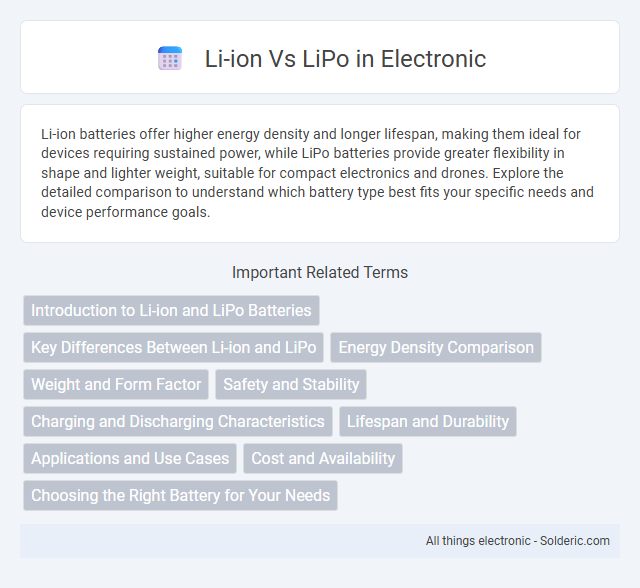Li-ion batteries offer higher energy density and longer lifespan, making them ideal for devices requiring sustained power, while LiPo batteries provide greater flexibility in shape and lighter weight, suitable for compact electronics and drones. Explore the detailed comparison to understand which battery type best fits your specific needs and device performance goals.
Comparison Table
| Feature | Li-ion (Lithium-ion) | LiPo (Lithium Polymer) |
|---|---|---|
| Energy Density | High (150-200 Wh/kg) | Moderate (100-150 Wh/kg) |
| Form Factor | Rigid cylindrical or prismatic cells | Flexible, pouch-style cells |
| Weight | Heavier due to metal casing | Lighter and thinner |
| Safety | Less tolerant to physical damage; risk of thermal runaway | Better tolerance to swelling and punctures |
| Cost | Generally lower | Typically higher due to complex manufacturing |
| Charging | Standard charging protocols | Flexible charging but requires careful voltage limits |
| Applications | Smartphones, laptops, electric vehicles | Drones, RC models, wearable devices |
| Cycle Life | Typically 500-1000 charge cycles | Usually 300-500 charge cycles |
Introduction to Li-ion and LiPo Batteries
Li-ion batteries use lithium ions moving between the anode and cathode to store and release energy, offering high energy density and long cycle life suitable for smartphones and laptops. LiPo batteries, a variant with a polymer electrolyte, provide flexible shapes and lighter weight, ideal for drones and RC vehicles where weight and form factor are critical. Understanding these differences helps you choose the best battery type for your device's performance and design requirements.
Key Differences Between Li-ion and LiPo
Li-ion batteries offer higher energy density and longer cycle life, making them ideal for devices requiring extended power, while LiPo batteries provide greater flexibility in shape and weight, enhancing design versatility for compact electronics. LiPo batteries utilize a gel-like electrolyte, which reduces the risk of leakage and allows for thinner packaging compared to the liquid electrolyte in Li-ion batteries. The higher safety profile of LiPo batteries comes at the cost of lower energy density, making Li-ion batteries preferable for high-capacity applications.
Energy Density Comparison
Lithium-ion (Li-ion) batteries generally offer higher energy density compared to Lithium Polymer (LiPo) batteries, enabling longer usage times in devices with the same weight or volume. Li-ion cells typically achieve energy densities around 150-250 Wh/kg, while LiPo cells usually range between 100-200 Wh/kg due to their flexible polymer electrolyte structure. Understanding this energy density difference helps you choose the most efficient battery type for applications requiring maximum power storage in compact spaces.
Weight and Form Factor
Li-ion batteries typically have a higher energy density, resulting in a heavier weight compared to LiPo batteries of the same capacity. LiPo battery cells are more flexible and can be manufactured in various shapes and sizes, making them ideal for compact and lightweight applications. The thinner, lighter form factor of LiPo batteries contributes to improved device portability and space efficiency in electronics like drones and smartphones.
Safety and Stability
Li-ion batteries offer higher energy density but have a greater risk of thermal runaway, making them less stable under extreme conditions. LiPo batteries utilize a gel-like electrolyte, enhancing flexibility and reducing the chance of leakage or explosion, resulting in improved safety for consumer electronics. Advanced battery management systems (BMS) further ensure safe charging and discharging cycles, critical for both Li-ion and LiPo technologies.
Charging and Discharging Characteristics
Li-ion batteries exhibit higher energy density and slower self-discharge rates, making them efficient for long-term energy storage, while LiPo batteries offer faster charging capabilities and better performance under high discharge rates due to their flexible polymer electrolyte. You should consider LiPo batteries for applications requiring rapid charge and discharge cycles, whereas Li-ion cells are suitable for devices needing consistent, extended battery life. Both battery types require precise charging control to prevent overheating or degradation, often managed by sophisticated battery management systems.
Lifespan and Durability
Li-ion batteries typically offer a longer lifespan, with around 500 to 1,000 full charge-discharge cycles before significant capacity loss, while LiPo batteries generally last for about 300 to 500 cycles. Li-ion cells provide better durability under varying temperature conditions and maintain capacity more efficiently over time. LiPo batteries, though lighter and flexible in design, are more prone to swelling and physical damage, affecting overall durability and safe usage.
Applications and Use Cases
Li-ion batteries are widely used in consumer electronics, electric vehicles, and energy storage systems due to their high energy density and long cycle life. LiPo batteries, valued for their flexibility and lightweight design, are preferred in drones, RC vehicles, and wearable devices where compactness and shape adaptability are crucial. Your choice between Li-ion and LiPo depends on the specific application requirements, including size constraints, weight, and necessary power output.
Cost and Availability
Li-ion batteries generally offer a lower cost per watt-hour and are widely available due to their extensive use in consumer electronics and electric vehicles, making them economically accessible for various applications. LiPo batteries tend to be more expensive because of their complex manufacturing process and specialized design, which limits their availability primarily to niche markets such as drones and RC devices. The broader supply chain and established production facilities for Li-ion cells contribute significantly to their affordability and widespread distribution.
Choosing the Right Battery for Your Needs
Li-ion batteries offer higher energy density and longer cycle life, making them ideal for devices requiring extended usage and compact design, such as smartphones and laptops. LiPo batteries provide greater flexibility in shape and size, along with improved safety and faster discharge rates, which suits applications like drones, RC cars, and wearable technology. Selecting the right battery depends on balancing energy capacity, weight constraints, and form factor to match the specific power demands and design parameters of your device.
Li-ion vs LiPo Infographic

 solderic.com
solderic.com